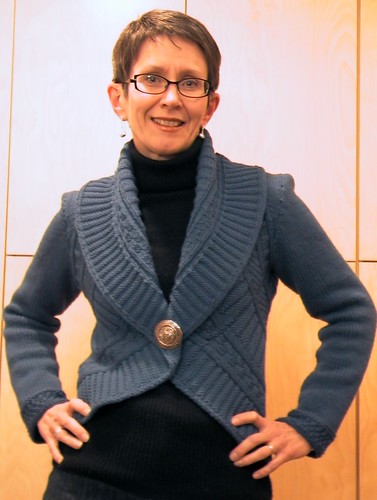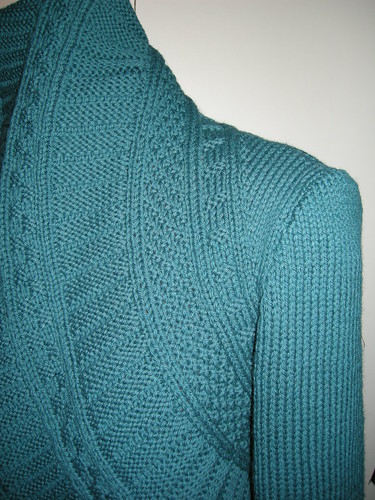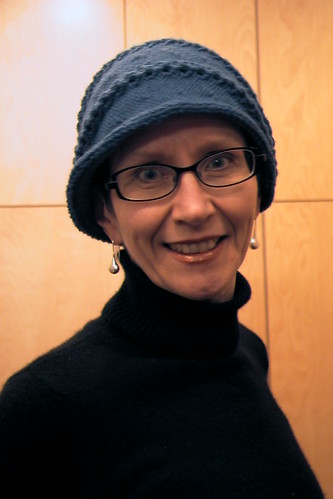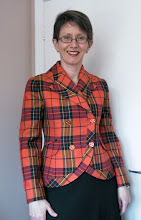While the Teal Jakku pieces were blocking I seem to have knit a hat out of my leftover wool. Please excuse my slightly stunned expression. I think it's caused by the unexpectedly speedy pace of my production.
This is the Tundra Toque, designed by Carolyn Doe (available on Ravelry). I love the asymmetrical shape. I'm not completely fond of inside-out stockinette stitch, and the fact that you can see the increases and decreases between the lacy cables on the brim. And I think the crown of the hat is too pointy. (I am trying to block it out.)

Here's another shot that shows the shape of the brim better. There are 5 cables that join in the centre of the crown. It goes pretty well with the resurrected Burda 7731 coat.

The other piece, of course, is the Teal Jakku. It took about 3 days for the pieces to dry, and another 3 to sew the thing together and weave in all the ends. (Am I supposed to sew it together and then block, or block before sewing? Experienced knitters, please advise.)
It has no closure. I've got this big silver pin that seems OK with it.
Thanks to the clearly explained knitting videos on KnittingHelp.com (also available as a $5 app for iPad - excellent value), the assembly of this project involved my first ever attempt at the Kitchener stitch, which is supposed to be completely invisible but in this case is merely not glaringly obvious. It was moderately difficult because I was seaming the deeply textured lower edge/collar, so there is a bit of disruption in the pattern. If you must know, it's mostly located under my left arm, but because of the angle of the pattern it isn't completely hidden by my arm. This location was suggested on Ravelry but in retrospect, I think the seam would have been less jarring if I'd placed it at the CB.
KnittingHelp also supplied a great explanation of the mattress stitch which I used to sew all the other pieces together pretty much invisibly.
For those of you who think I've gone over to the dark side and are wondering when The Sewing Lawyer is going to resume producing more interesting projects, here are a few sewing-related thoughts on knitting design and construction.
 According to some things I've read on the internet, some knitters will go to great lengths to avoid having to actually sew their knitted garments together. They'll knit a piece entirely in the round from the bottom up or the top down, splitting off at the shoulders to form separate in-the-round tubes for the sleeves, including increases and decreases to build in shaping (where you'd sew darts), and cleverly finding ways to include hems, pockets, buttonholes, collars and all manner of details which are joined by picking up stitches and knitting new details directly onto a completed piece. For example, the cloche hat brim is seamed at its narrowest point, but the crown is then knitted round and round, decreasing from 100 stitches picked up from one edge of the assembled brim. It's a new world.
According to some things I've read on the internet, some knitters will go to great lengths to avoid having to actually sew their knitted garments together. They'll knit a piece entirely in the round from the bottom up or the top down, splitting off at the shoulders to form separate in-the-round tubes for the sleeves, including increases and decreases to build in shaping (where you'd sew darts), and cleverly finding ways to include hems, pockets, buttonholes, collars and all manner of details which are joined by picking up stitches and knitting new details directly onto a completed piece. For example, the cloche hat brim is seamed at its narrowest point, but the crown is then knitted round and round, decreasing from 100 stitches picked up from one edge of the assembled brim. It's a new world. Sewing a knitted thing together with the same wool it's made from, and carefully picking up a row or stitch at a time at each edge of a seam means that even if the thing isn't knitted together, it looks like it was. The perfectionist in me really likes this fact.
As Sherry pointed out in a comment to my last post, the fact that knitted pieces stretch means they can be forced to go together, but this isn't necessarily a good thing. Understanding how flat shapes best fit the 3 dimensional human body without distortion (i.e. how sewing patterns work) seems immensely useful to me in knitting. My decision that I should insert a little triangle at the front shoulder area, instead of forcing a smoothly curved piece to fill in a right angle corner was definitely the right one.
I have a pair of badly needed black pants cut out; they'll look smashing with the jakku.




I like your idea about the triangular piece but I'm not sure where you are talking about putting it. Is there a way you can show us? Beautiful work. I'm going to study what you've done because I have a set-in sleeve to place in a sweater I'm working on right now. Thanks for the help!
ReplyDeleteThey're both super cute, Kay! Congratulations. :)
ReplyDeleteoh my goodness! I'm so impressed. Love the colour, the shape, the look. Love the hat. where/how did you learn to knit?
ReplyDeleteOh, Kay, that jaku is fabulous and beyond! I'm so glad I moved to the tropics (from Nova Scotia) so I don't need to feel guilty about not making one like it.
ReplyDeleteThose are so pretty! I figured out what "FKOs" was, but the acronym did make me chuckle!
ReplyDeleteAbout 15 years ago my old Singer sewing machine was developing serious problems and I needed to get a home computer. Because space was limited in my apartment, I put the sewing machine on the floor of a closet. After a couple of weeks I started knitting--and I couldn't stop! And then I discovered the many knitting sites on the Internet (and this was long before Ravelry!). All this led to a frenzy of knitting, learning new knitting skills, stashing yarn, and even designing. Now I live in a larger house, and some months ago I bought a very good replacement sewing machine, and now I am just beginning to discover sewing again. And once again the Internet has shown me techniques and skills that I never knew before. Now I'm dividing my free time between sewing and knitting. But knitting can allow you to do things that sewing can't. The ability to shape fabric as you go (no need for darts) and the chance to pair a specific yarn with any stitch you want to create any knitted fabric and almost any shape you want can be addicting. You're right--a knowledge of how sewing works and how pieces fit together can make knitting even more rewarding (and I'm always surprised when knitters lack this knowledge). There are some good books on designing your own knitted garments and many good stitch guides. It's great fun. But be careful--moderation is hard to achieve! I know!
ReplyDeleteWonderful work! As far as blocking I have done it both ways before sewing the pieces together and after. I decide depending on the project, sometimes the knitted fabric is really out of shape and so I block first (after weaving in any ends that are not on the edge of the fabric) so that I have nicely shaped pieces to sew together. Sometimes the knitted fabric does not follow traditional pieces (like shrugs) and I do the blocking once the garment is finished. HTH.
ReplyDeleteLisette
OMGosh..what a wonderful set...it's PERFECT!
ReplyDeleteVery, very impressive - and lovely, and functional, and becoming. Are you changing your title to The Knitting Lawyer now......?
ReplyDeleteThe sweater is just gorgeous. Excellent work.
ReplyDeleteYour work is simply amazing! I am just learning how to knit myself, and have just completed my first project a scarf. I love your blog! I peek in every week to see your wonderful creations!
ReplyDeleteLove the jacket but instead of Kitchener Stitch, why did you not just knit the two rows together and simultaneously cast off? It's a long time since I knitted a garment but I think that this would work anytime you have two uncast off edges that need to be joined together. You are quite right, I hated sewing up but that was probably because I am such a control freak that the inside had to look as good as the outside or I couldn't wear it. I was always worried in case I was run over and someone saw the loose ends or knots.
ReplyDeleteOne problem with knitting that you do not get with sewing is that the yarn manufacturers can be a bit naughty and suddenly you find a knot in the middle of the wool. I used to have to pull back the row to the beginning and leave a long end that could be incorporated into the side seam rather than have a knot in the body of the sweater.
I agree with your comments about fitting and knitting and sewing. i have sewnn for years and just started knitting and am AMAZED at how little knitters seem to know or care about fitting. So frustrating. However, I am using what I know from sewing, as you do.
ReplyDelete